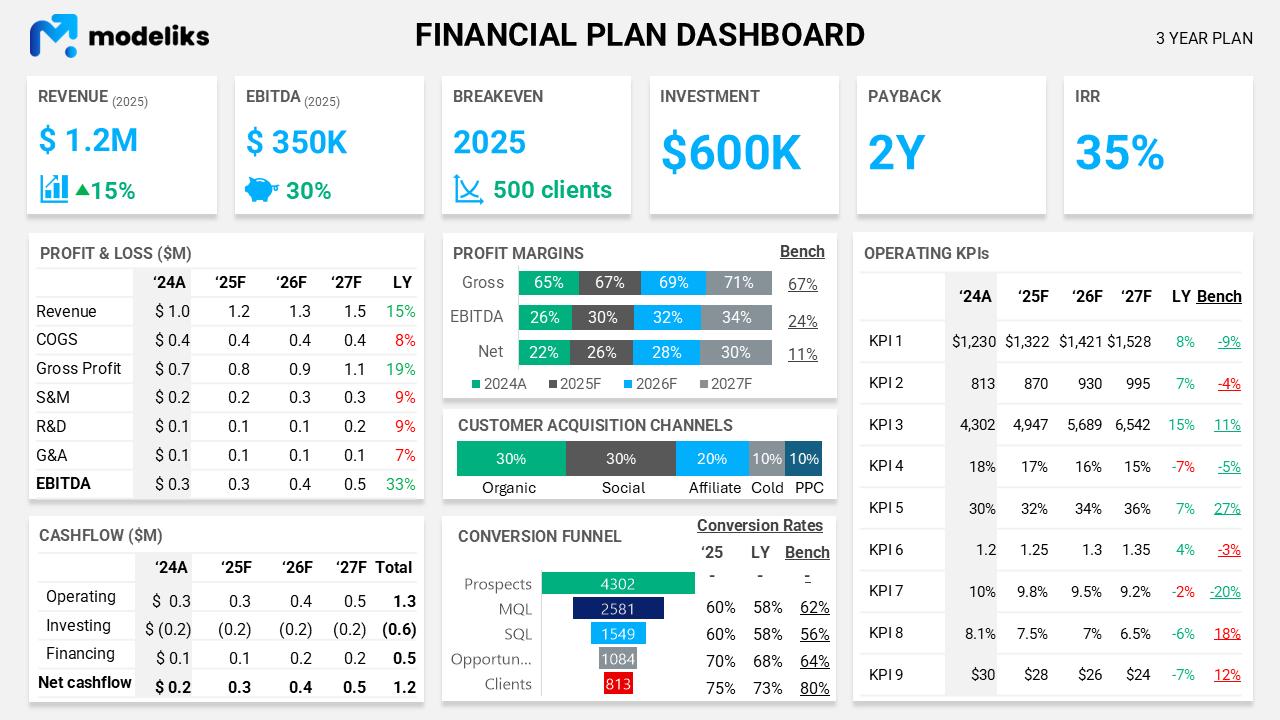Our Health and Beauty Products Wholesale Financial Model Structure covers all the essential aspects you need to consider when starting or scaling a Health and Beauty Products Wholesale business. By following this structure, you can better understand your revenue streams, costs, and assets, helping you optimize profitability and strategically plan for growth.
Health and Beauty Products Wholesale Financial Model Structure
Crafting a financial plan for your Health and Beauty Products Wholesale business is crucial for ensuring your venture’s success and sustainability. This model outlines typical revenues, direct costs, employees, expenses, and assets you need to consider when starting or growing your business. By understanding these elements, you can uncover new and profitable revenue streams. The structure of the Health and Beauty Products Wholesale financial model, however, is complex: it requires careful attention to detail because each component interrelates. Although some aspects may seem straightforward, they can become intricate upon closer examination, thus necessitating a thorough approach.
Revenues
The typical revenue streams for a Health and Beauty Products Wholesale business encompass several avenues:
- Product Sales —this refers to revenue generated from selling beauty and health products. It is calculated by multiplying unit price by number of units sold.
- Bulk Orders yield income from large quantity orders, which are often offered at discounted rates; this depends on negotiated terms with clients.
- Subscription Services provide monthly or yearly subscriptions for regular product deliveries (multiply the subscription fee) by the number of subscribers.
- Private Label Agreements generate revenue from manufacturing products for other brands, calculated based on agreed manufacturing costs and profits.
- Online Sales result in income derived from e-commerce channels, where one calculates by considering average order value and order frequency.
- Wholesale Partnerships yield revenue from partnerships with retailers and salon chains (this is based on contractual terms and sales volume).
- Exclusive Distribution Rights involve fees for exclusive rights to distribute particular products; however, this depends on the agreement with product manufacturers.
Cost of goods sold
Corresponding costs for these revenue streams, which are crucial, include:
- Raw Material Costs : Expenses for ingredients or components needed for products.
- Manufacturing Costs : Costs associated with production process, including labor and utilities.
- Packaging Costs : Expenses for packaging materials and design services.
- Shipping and Logistics : Costs for transporting goods to warehouses or direct to customers.
- Inventory Storage : Charges for storing products in warehouses or fulfillment centers.
However, these costs fluctuate significantly, because they are influenced by market conditions. Although it may seem straightforward, navigating these expenses can be complex, and this complexity often leads to inefficiencies.
Employees
The essential employees for a Health and Beauty Products Wholesale business include:
- Operations Manager : Oversees daily operations and ensures smooth supply chain management.
- Sales Executive : Manages client relationships and drives sales growth because they are pivotal to success.
- Marketing Specialist : Develops marketing strategies and campaigns to promote products.
- Warehouse Staff : Responsible for inventory management and order fulfillment.
- Customer Service Representative : Handles client inquiries, assists with order issues, and this role is crucial for maintaining client satisfaction.
Operating expenses
Typical operating expenses include:
- Rent : The cost of leasing commercial space for offices or warehouses can be significant.
- Utilities : These expenses, which include electricity, water, and gas usage, add to the overall financial burden.
- Salaries and Wages : Represent payments to employees for their labor; however, this is essential for maintaining a motivated workforce.
- Marketing and Advertising : Costs are necessary for promoting products and services, although they can quickly escalate.
- Insurance : Premiums are critical for business liability, product, and employee coverage because they provide essential protection.
- Professional Fees : For legal, accounting, and consultation services can strain budgets, but they are often unavoidable.
- IT and Software : Costs for maintaining technological infrastructure and software licenses are increasingly relevant in today’s digital age.
- Office Supplies : Expenses, which encompass basic office necessities like stationery, might seem trivial, but they accumulate.
- Transportation : Costs are associated with business-related travel and shipments.
- Maintenance and Repairs : Are vital for the upkeep of facilities and equipment, thus ensuring smooth operations.
Assets
Typical assets for a Health and Beauty Products Wholesale business include:
- Warehouse Facilities : Which provide space for storing inventory before distribution.
- Delivery Vehicles : Essential for logistical operations.
- Office Equipment : Such as computers, printers, and telecommunication devices.
- Inventory : The stock of goods available for sale.
- Point of Sale Systems : Both equipment and software used to process transactions.
However, this collection of assets is crucial because it ensures efficiency and effectiveness in business operations. Although these elements may seem basic, they play significant roles in the overall success of the enterprise.
Funding options
The conventional funding avenues for such a business encompass various options:
- Bank Loans : Represent traditional funding from financial institutions, predicated on creditworthiness.
- Venture Capital : Equity financing sourced from investors who seek business growth potential.
- Angel Investors : Individuals providing capital in exchange for equity.
- Government Grants : Non-repayable funds allocated for specific business activities.
- Crowdfunding : A collective effort by individuals contributing small amounts of money.
Driver-based Financial Model for Health and Beauty Products Wholesale
However, it is important to understand that these metrics are not just numbers, but rather critical indicators of business health. Although some may overlook their significance, they provide invaluable insights into operational efficiency. Because of this, maintaining a keen focus on these KPIs is imperative for sustained growth and profitability in the competitive landscape of Health and Beauty Products Wholesale.
Driver-based financial planning is a process aimed at identifying key activities (often termed ‘drivers’) that exert the greatest influence on business outcomes; however, it involves constructing financial plans rooted in those activities. This methodology enables the establishment of relationships between financial results and necessary resources (such as personnel, marketing budgets, equipment, etc.). If you seek to gain further insights into driver-based financial planning and its appropriateness as a planning strategy, consider the founder of Modeliks elucidating it in the video below.
Need a business plan?
Create one with Modeliks AI in the next hour!
AI powered business planning for Startups and SMEs.
The financial plan output
The objective of the financial forecast outputs is to enable you, your management team, board, or investors to:
- Quickly grasp how your Health and Beauty Products Wholesale enterprise will perform in the future.
- Provide comfort that the plan is well thought out, realistic, and achievable.
- Clarify what investment is necessary to execute this plan and what the return on investment will be.
To attain these goals, here is a one-page template for effectively presenting your financial plan.

Aside from this one-page summary of your plan, you will also need the three projected financial statements:
- Profit and Loss
- Balance Sheet
- Cash Flow Statement
Health and Beauty Products Wholesale financial model summary
A professional Health and Beauty Products Wholesale financial model will assist you in contemplating your business, identifying resources needed to achieve your targets, set goals, measure performance, raise funding, and make confident decisions to manage and grow your business. However, this process can be complex, but it is essential because it shapes your strategic direction. Although challenges may arise, staying focused on these elements is crucial for success.
If you need help with your financial plan, try Modeliks , a financial planning solution for SMEs and startups or contact us at contact@modeliks.com and we can help.
Author:
Blagoja Hamamdjiev
, Founder and CEO of
Modeliks
, Entrepreneur, and business planning expert.
In the last 20 years, he helped everything from startups to multi-billion-dollar conglomerates plan, manage, fundraise, and grow.

TAKE MODELIKS FOR A SPIN
Not sure which plan?
Start with a 15 days free trial.
You will have access to the full functionality of Modeliks. The only restriction in the free trial is that you cannot download or share your business plan outside Modeliks. Credit card is not required to subscribe for the free trial.






